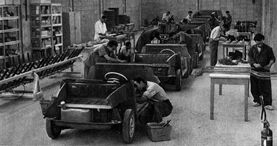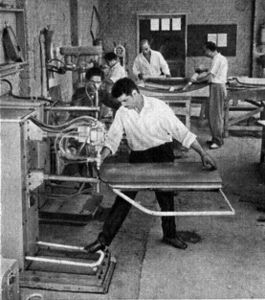It will be called "Ramses"! So decides the Rais. This will be, by the presidential will, the name of the first car, not only "made in Egypt", but "Egyptian".
It is the late 1950s. In the wake of the 1952 Revolution in which the Free Officers overthrew the monarchy, the Aswan High Dam project and the nationalization of the Suez Canal, the final blow to the British protectorate, Gamal Abdel Nasser wants to bring his country into the modern industrial era. With the emergence of economic development projects, there is a high demand for vehicles in Egypt, particularly to allow millions of Egyptians to regroup in urban areas and work in factories or in newly built industrial centers. And while we're at it, while we're driving, let's drive "Egyptian"! In addition to the job creation it will bring, a clean automobile industry will be another logical manifestation of independence and national pride.
But there is a long way to go between dream and reality, the major obstacles being obviously linked to the lack of experience, and therefore to a deficit of technical skills in the matter. It does not take more to give ideas to Raymond Flower, a former captain of the British army, originally from Alexandria. This car enthusiast himself drives, on European circuits, his Phoenix 2SR6, assembled in an assembly plant in Alexandria. So he knocks on the door of the Raïs to present to him a project to build a small affordable car for the Egyptian people: the "Frisky".
Gamal Abdel Nasser expressed interest in the proposal, but he asked to see it. As an expert, he demanded in particular some technical modifications… as well as a change of name, “Ramses” replacing “Frisky”! And so it was that 25 demonstration cars, manufactured in Great Britain, were imported into Egypt, via the port of Alexandria, and paraded in Tahrir Square for the ceremonies of July 23, 1959 - the anniversary of the 1952 Revolution -, after having been duly painted in the colors of Egypt. And the appropriate slogans were out: “A car built by Arab hands for the Arab people”; “They thought we only had camels, but now we make our own cars!”

1954 Ramses Saloon car advert

In 1959, a plot of land was allocated on Pyramid Street in Cairo for the establishment of the future factory and the managers of the new Egypt Light Transportation Manufacturing Company went shopping for the launch of a production line of a thousand cars. First, they headed to Great Britain, on the instructions of Raymond Flower. The reception they received was "polite", but the British government took a dim view of the establishment of a competing industry on Egyptian soil. The delegation had nothing else to do but take the first plane to Stuttgart, where the Neckarsulm Strickmaschinen Union (NSU) immediately expressed its eagerness. Raymond Flower was forced to withdraw to his English lands to develop his three-wheeled "Frisky", while the Egyptian "Ramses" was born according to the Prinz concept for the engine (engine at the rear), and with the technical contribution of Carrozeria Bertone SpA for the bodywork, the rest (seats, trim, floor mats, etc.) being locally manufactured. Thus, instead of being a "Frisky", the "Ramsè" became a disguised Prinz NSU!
In 1959, the "first Arab car" was born and was assembled by hand, based on the NSU Prinz 30, at a rate of 5 to 6 vehicles per day. The first model was the "Ramsès Utilica" with an "angular" body, a two-cylinder engine, an air-cooling system, a displacement of 598 cc, a power of 22 kW and a top speed of 116 km/h. Until 1963, 1130 units of this model will be built.
It was succeeded by the "Ramses II", from 1963 to 1966, a limousine similar to the NSU Prinz IV (1700 units), the "Ramses Gamila" coupé, whose body was designed by the Italian Alfredo Vignale (very few examples), the "Ramses II" (1700 units), the "Ramses III", manufactured in "self-development", only the engines and body parts still coming from the two European companies (result: an economic fiasco for this model), the "Ramses IV", a four-door three-box saloon in the upper middle category, which remained at the prototype stage.

In 1967, what seemed inevitable in a context of international competition and the removal of subsidies from the Egyptian state happened: production of the “Ramses” was stopped. A rather complex synergy then took place, for the production of motorcycles and utility vehicles, between the Watania Automotive Manufacturing Company (WAMCO), which succeeded the Egypt Light Transportation Manufacturing Company, and the manufacturer El-Nasr, whose commercial objective was to find help from foreign manufacturers and to build vehicles under license, well adapted to the Egyptian market: models derived from Fiats manufactured under license in Poland by Fabryka Samochodów Osobowych (F.S.O.) and in Yugoslavia by Zastava.
Due to production conditions and unreliability of the vehicles, the "Ramses" therefore disappeared from the Egyptian scene. Born from a nationalist dream nourished by the builders of modern Egypt, it unfortunately never lived up to the expectations or ambitions it could inspire.
"It was a lovely dream. Unfortunately, it came to an end."
With their legendary sense of humor, the Egyptians had a comeback when they saw a "Ramses" succumbing to the unfortunate habit of breaking down. Addressing the driver, they would address him in these terms: "Make her smell an onion, it might wake her up!" Unfortunately, the no less famous Egyptian onion probably also has its limits!













Comments